文章目录
- 基础流
- 1、IO概述
- 1.1 什么是IO
- 1.2 IO的分类
- 1.3 顶级父类们
- 2、字节流
- 2.1 一切皆为字节
- 2.2 字节输出流 OutputStream
- 2.3 FileOutputStream类
- 2.3.1 构造方法
- 2.3.2 写出字节数据
- 2.3.3 数据追加续写
- 2.3.4 写出换行
- 2.4 字节输入流 InputStream
- 2.5 FileInputStream类
- 2.5.1 构造方法
- 2.5.2 读取字节数据
- 2.6 字节流练习-文件拷贝
- 3、字符流
- 3.1 字符输入流 Reader
- 3.2 FileReader类
- 3.2.1 构造方法
- 3.2.2 读取字符数据
- 3.3 字符输出流 Writer
- 3.4 FileWriter类
- 3.4.1 构造方法
- 3.4.2 基本写出数据
- 3.4.3 关闭和刷新
- 3.4.4 写出其他数据
- 4、IO异常的处理
- 4.1 JDK7前处理
- 4.2 JDK7的处理
- 4.3 JDK9的改进
- 5、阶段练习
- 5.1 拷贝文件夹
- 5.2 文件加密
- 5.3 数字排序
- 高级流
- 1、缓冲流
- 1.1 概述
- 1.2 字节缓冲流
- 1.2.1 构造方法
- 1.2.2 效率测试
- 1.3 字符缓冲流
- 1.3.1 构造方法
- 1.3.2 特有方法
- 1.4 练习-文本排序
- 1.5 练习-程序运行次数限制
- 2、转换流
- 2.1 字符编码和字符集
- 2.1.1 字符编码
- 2.1.2 字符集
- 2.2 编码引出的问题
- 2.3 InputStreamReader类
- 2.3.1 构造方法
- 2.3.2 指定编码读取
- 2.4 OutputStreamWriter类
- 2.4.1 构造方法
- 2.4.2 指定编码写出
- 2.5 练习-转换文件编码
- 2.6 练习-按行读取数据
- 3、序列化流
- 3.1 概述
- 3.2 ObjectOutputStream类
- 3.2.1 构造方法
- 3.2.2 序列化操作
- 3.3 ObjectInputStream类
- 3.3.1 构造方法
- 3.3.2 反序列化操作
- 3.3.3 反序列化操作问题
- 3.4 练习-序列化集合
- 4、打印流
- 4.1 概述
- 4.2 字节打印流PrintStream
- 4.2.1 构造方法
- 4.2.2 改变打印流向
- 4.2.3 字节打印流基本使用
- 4.3 字符打印流
- 5、压缩流和解压缩流
- 5.1 解压流 ZipInputStream
- 5.2 压缩流 ZipOutputStream
- 5.2.1 压缩单个文件
- 5.2.2 压缩多级文件夹
- 6、工具包 Commons-io
- 7、工具包 Hutool
- 8、配置文件操作IO流
- 8.1 向配置文件中存放数据
- 8.2 读取配置文件的数据
基础流
1、IO概述
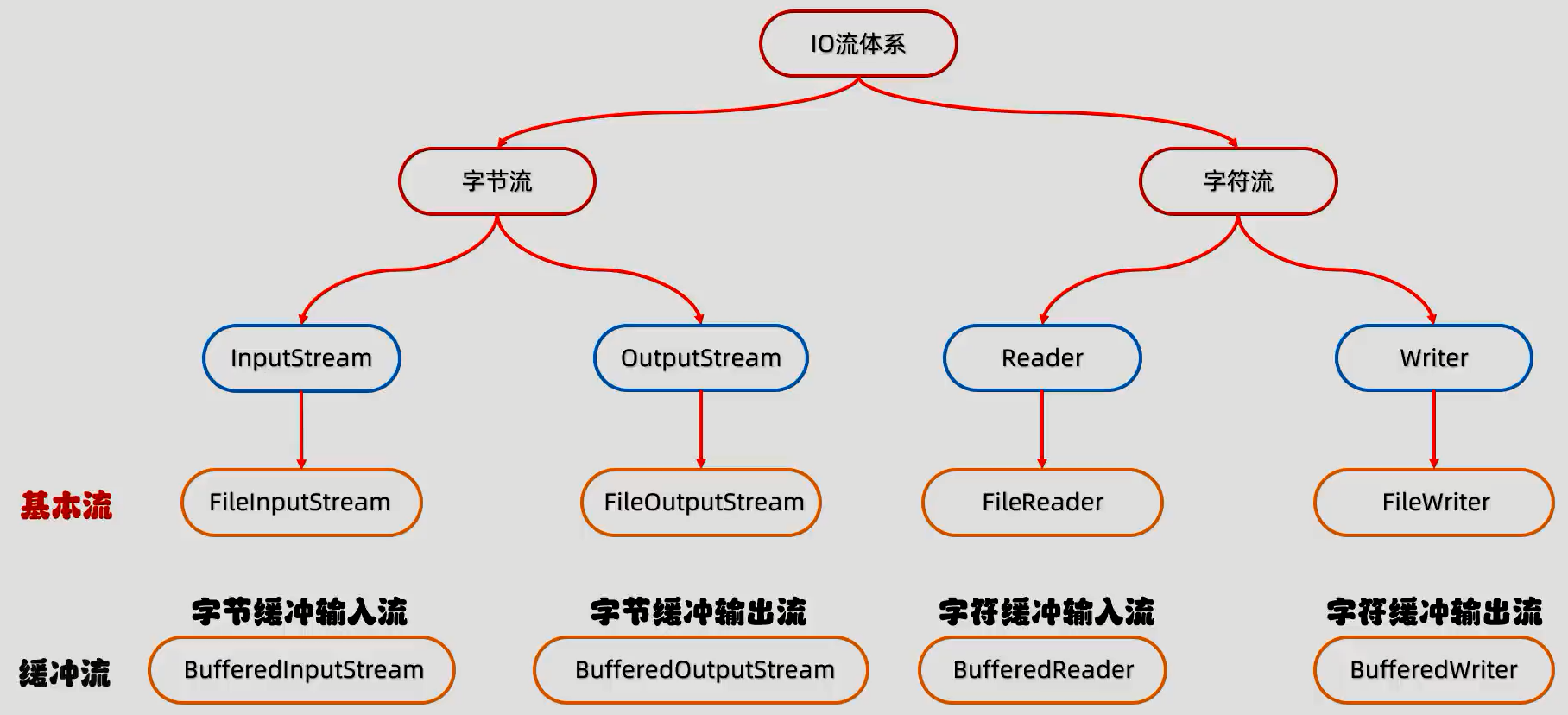
1.1 什么是IO
数据的传输可以看做是一种数据的流动,按照流动的方向,以内存为基准,分为输入input 和输出output ,即流向内存是输入流,流出内存的输出流。
Java中I/O操作主要是指使用java.io包下的内容,进行输入、输出操作。输入也叫做读取数据,输出也叫做作写出数据。
1.2 IO的分类
根据数据的流向分为:输入流和输出流。
- 输入流 :把数据从
其他设备上读取到内存中的流。 - 输出流 :把数据从
内存中写出到其他设备上的流。
格局数据的类型分为:字节流和字符流。
- 字节流 :以字节为单位,读写数据的流。
- 字符流 :以字符为单位,读写数据的流。
输入:硬盘–>内存
输出:内存–>硬盘
1.3 顶级父类们
| 输入流 | 输出流 | |
|---|---|---|
| 字节流 | 字节输入流InputStream | 字节输出流OutputStream |
| 字符流 | 字符输入流Reader | 字符输出流Writer |
一个简单的方法判断文件存储是否是字符流:将文件使用Windows自带的文本编辑器打开,能直接看懂的是字符流,不能直接看懂的(比如乱码)是字节流。
2、字节流
字节流读取文件的时候,文件中不要有中文。
2.1 一切皆为字节
一切文件数据(文本、图片、视频等)在存储时,都是以二进制数字的形式保存,都一个一个的字节,那么传输时一样如此。所以,字节流可以传输任意文件数据。
2.2 字节输出流 OutputStream
java.io.OutputStream 抽象类是表示字节输出流的所有类的超类,将指定的字节信息写出到目的地。它定义了字节输出流的基本共性功能方法。
public void close():关闭此输出流并释放与此流相关联的任何系统资源。public void flush():刷新此输出流并强制任何缓冲的输出字节被写出。public void write(byte[] b):将 b.length字节从指定的字节数组写入此输出流。public void write(byte[] b, int off, int len):从指定的字节数组写入 len字节,从偏移量 off开始输出到此输出流。public abstract void write(int b):将指定的字节输出流。
对于close方法:当完成流的操作时,必须调用此方法,释放系统资源。
2.3 FileOutputStream类
OutputStream有很多子类,从最简单的一个子类开始。java.io.FileOutputStream 类是文件输出流,用于将数据写出到文件。
2.3.1 构造方法
public FileOutputStream(File file):创建文件输出流以写入由指定的 File对象表示的文件。public FileOutputStream(String name): 创建文件输出流以指定的名称写入文件。
当你创建一个流对象时,必须传入一个文件路径。该路径下,如果没有这个文件,会创建该文件。如果有这个文件,会清空这个文件的数据。
代码示例:
public class FileOutputStreamConstructor throws IOException {public static void main(String[] args) {// 使用File对象创建流对象File file = new File("a.txt");FileOutputStream fos = new FileOutputStream(file);// 使用文件名称创建流对象FileOutputStream fos = new FileOutputStream("b.txt");}
}
2.3.2 写出字节数据
(1)写出字节:write(int b) 方法,每次可以写出一个字节数据,代码使用演示:
实现需求:写出一段文字到本地文件中。(暂时不写中文)
实现步骤:创建对象写出数据释放资源
public class FileOutputStreamDemo01 {public static void main(String[] args) throws IOException {//1.创建对象//写出 输出流 OutputStream//本地文件 FileFileOutputStream fos = new FileOutputStream("my-io\\a.txt");//2.写出数据fos.write(97);//3.释放资源fos.close();}
}

注:
- 虽然参数为int类型四个字节,但是只会保留一个字节的信息写出。
- 流操作完毕后,必须释放系统资源,调用close方法,千万记得。
- 创建字节输出流对象
- 参数是字符串表示的路径或者是File对象都是可以的
- 如果文件不存在会创建一个新的文件,但是要保证父级路径是存在的。
- 如果文件已经存在,则会清空文件
- 写数据
- write方法的参数是整数,但是实际上写到本地文件中的是整数在ASCII上对应的字符
‘9’
'7’
(2)写出字节数组:write(byte[] b),每次可以写出数组中的数据,代码使用演示:
void write(byte[] b):一次写一个字节数组数据
public class FileOutputStreamDemo03 {public static void main(String[] args) throws IOException {//1.创建对象FileOutputStream fos = new FileOutputStream("my-io\\a.txt");//2.一次写一个字节数组数据byte[] bytes = {97, 98, 99, 100, 101};fos.write(bytes);//4.释放资源fos.close();}
}

(3)写出指定长度字节数组:write(byte[] b, int off, int len) ,每次写出从off索引开始,len个字节,代码使用演示:
void write(byte[] b, int off, int len) 一次写一个字节数组的部分数据
参数一:数组
参数二:起始索引
参数三:个数
public class FileOutputStreamDemo03 {public static void main(String[] args) throws IOException {//1.创建对象FileOutputStream fos = new FileOutputStream("my-io\\a.txt");//2.一次写一个字节数组数据byte[] bytes = {97, 98, 99, 100, 101};//3.一次写一个字节数组的部分数据fos.write(bytes,1,2); // b c//4.释放资源fos.close();}
}

2.3.3 数据追加续写
经过以上的演示,每次程序运行,创建输出流对象,都会清空目标文件中的数据。需要在构造方法的参数传入一个boolean类型的值,true 表示追加数据,false 表示清空原有数据。这样创建的输出流对象,就可以指定是否追加续写了。
public FileOutputStream(File file, boolean append): 创建文件输出流以写入由指定的 File对象表示的文件。public FileOutputStream(String name, boolean append): 创建文件输出流以指定的名称写入文件。
代码示例:
public class FileOutputStreamDemo04 {public static void main(String[] args) throws IOException {//1.创建对象,开启续写FileOutputStream fos = new FileOutputStream("my-io\\a.txt",true);//2.写出数据String str = "Hello";byte[] bytes = str.getBytes();fos.write(bytes);//3.释放资源fos.close();}
}

2.3.4 写出换行
Windows系统里,换行符号是\r\n
public class FileOutputStreamDemo04 {public static void main(String[] args) throws IOException {// 使用文件名称创建流对象FileOutputStream fos = new FileOutputStream("my-io\\a.txt");// 定义字节数组byte[] words = {97,98,99,100,101};// 遍历数组for (int i = 0; i < words.length; i++) {// 写出一个字节fos.write(words[i]);// 写出一个换行, 换行符号转成数组写出fos.write("\r\n".getBytes());}// 关闭资源fos.close();}
}
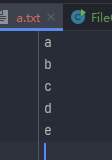
- 回车符
\r和换行符\n:
- 回车符:回到一行的开头(return)。
- 换行符:下一行(newline)。
- 系统中的换行:
- Windows系统里,每行结尾是
回车+换行,即\r\n;- Unix系统里,每行结尾只有
换行,即\n;- Mac系统里,每行结尾是
回车,即\r。从 Mac OS X开始与Linux统一。
2.4 字节输入流 InputStream
java.io.InputStream 抽象类是表示字节输入流的所有类的超类,可以读取字节信息到内存中。它定义了字节输入流的基本共性功能方法。
public void close():关闭此输入流并释放与此流相关联的任何系统资源。public abstract int read(): 从输入流读取数据的下一个字节。public int read(byte[] b): 从输入流中读取一些字节数,并将它们存储到字节数组 b中 。
close方法,当完成流的操作时,必须调用此方法,释放系统资源。
2.5 FileInputStream类
java.io.FileInputStream 类是文件输入流,从文件中读取字节。
2.5.1 构造方法
创建一个流对象时,必须传入一个文件路径。该路径下,如果没有该文件,会抛出FileNotFoundException 。
FileInputStream(File file): 通过打开与实际文件的连接来创建一个 FileInputStream ,该文件由文件系统中的 File对象 file命名。FileInputStream(String name): 通过打开与实际文件的连接来创建一个 FileInputStream ,该文件由文件系统中的路径名 name命名。
代码示例:
public class FileInputStreamConstructor throws IOException{public static void main(String[] args) {// 使用File对象创建流对象File file = new File("a.txt");FileInputStream fos = new FileInputStream(file);// 使用文件名称创建流对象FileInputStream fos = new FileInputStream("b.txt");}
}
2.5.2 读取字节数据
(1)读取字节:read方法,每次可以读取一个字节的数据,提升为int类型,读取到文件末尾,返回-1,代码使用演示:
public class FileInputStreamDemo01 {public static void main(String[] args) throws IOException {//1.创建对象FileInputStream fis = new FileInputStream("my-io\\a.txt");//2.读取数据,返回一个字节int read = fis.read();System.out.println((char) read);read = fis.read();System.out.println((char) read);read = fis.read();System.out.println((char) read);read = fis.read();System.out.println((char) read);read = fis.read();System.out.println((char) read);// 读取到末尾,返回-1read = fis.read();System.out.println( read);//3.关闭资源fis.close();}
}

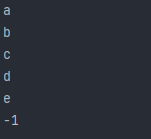
循环改进读取方式,代码使用演示:
public class FileInputStreamDemo03 {public static void main(String[] args) throws IOException {// 使用文件名称创建流对象FileInputStream fis = new FileInputStream("my-io\\a.txt");// 定义变量,保存数据int b;// 循环读取while ((b = fis.read()) != -1) {System.out.println((char) b);}// 关闭资源fis.close();}
}
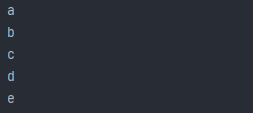
- 虽然读取了一个字节,但是会自动提升为int类型。
- 流操作完毕后,必须释放系统资源,调用close方法,千万记得。
(2)使用字节数组读取:read(byte[] b),每次读取b的长度个字节到数组中,返回读取到的有效字节个数,读取到末尾时,返回-1 ,代码使用演示:
public class FileInputStreamDemo05 {public static void main(String[] args) throws IOException {//1.创建对象FileInputStream fis = new FileInputStream("my-io\\a.txt");//2.读取数据byte[] bytes = new byte[2];//一次读取多个字节数据,具体读多少,跟数组的长度有关//返回值:本次读取到了多少个字节数据int len1 = fis.read(bytes);System.out.println(len1);//2String str1 = new String(bytes,0,len1);System.out.println(str1);//abint len2 = fis.read(bytes);System.out.println(len2);//2String str2 = new String(bytes,0,len2);System.out.println(str2);//cdint len3 = fis.read(bytes);System.out.println(len3);// 1String str3 = new String(bytes,0,len3);System.out.println(str3);//e//3.释放资源fis.close();}
}
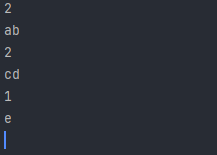
2.6 字节流练习-文件拷贝
选择一个比较小的文件,不要太大。大文件拷贝之后学。

(1)不使用字节数组拷贝
public class FileInputStreamDemo04 {public static void main(String[] args) throws IOException {long start = System.currentTimeMillis();//1.创建对象FileInputStream fis = new FileInputStream("D:\\aaa\\movie.mp4");FileOutputStream fos = new FileOutputStream("my-io\\copy.mp4");//2.拷贝//核心思想:边读边写int b;while((b = fis.read()) != -1){fos.write(b);}//3.释放资源//规则:先开的最后关闭fos.close();fis.close();long end = System.currentTimeMillis();System.out.println(end - start);}
}

(2)使用字节数组进行拷贝
public class FileInputStreamDemo06 {public static void main(String[] args) throws IOException {long start = System.currentTimeMillis();//1.创建对象FileInputStream fis = new FileInputStream("D:\\aaa\\movie.mp4");FileOutputStream fos = new FileOutputStream("my-io\\copy.mp4");//2.拷贝int len;byte[] bytes = new byte[1024 * 1024 * 5];while((len = fis.read(bytes)) != -1){fos.write(bytes,0,len);}//3.释放资源fos.close();fis.close();long end = System.currentTimeMillis();System.out.println(end - start);}
}
流的关闭原则:先开后关,后开先关。

3、字符流
当使用字节流读取文本文件时,可能会有一个小问题。就是遇到中文字符时,可能不会显示完整的字符,那是因为一个中文字符可能占用多个字节存储。所以Java提供一些字符流类,以字符为单位读写数据,专门用于处理文本文件。
3.1 字符输入流 Reader
java.io.Reader抽象类是表示用于读取字符流的所有类的超类,可以读取字符信息到内存中。它定义了字符输入流的基本共性功能方法。
public void close():关闭此流并释放与此流相关联的任何系统资源。public int read(): 从输入流读取一个字符。public int read(char[] cbuf): 从输入流中读取一些字符,并将它们存储到字符数组 cbuf中 。
3.2 FileReader类
java.io.FileReader 类是读取字符文件的便利类。构造时使用系统默认的字符编码和默认字节缓冲区。
- 字符编码:字节与字符的对应规则。Windows系统的中文编码默认是GBK编码表;idea中是Unicode字符集、UTF-8编码
- 字节缓冲区:一个字节数组,用来临时存储字节数据。
3.2.1 构造方法
创建一个流对象时,必须传入一个文件路径,类似于FileInputStream 。
FileReader(File file): 创建一个新的 FileReader ,给定要读取的File对象。FileReader(String fileName): 创建一个新的 FileReader ,给定要读取的文件的名称。
代码示例:
public class FileReaderConstructor throws IOException{public static void main(String[] args) {// 使用File对象创建流对象File file = new File("a.txt");FileReader fr = new FileReader(file);// 使用文件名称创建流对象FileReader fr = new FileReader("b.txt");}
}
3.2.2 读取字符数据
第一步:创建对象
public FileReader(File file) 创建字符输入流关联本地文件
public FileReader(String pathname) 创建字符输入流关联本地文件
第二步:读取数据
public int read() 读取数据,读到末尾返回-1
public int read(char[] buffer) 读取多个数据,读到末尾返回-1
第三步:释放资源
public void close() 释放资源/关流
(1)读取字符:read方法,每次可以读取一个字符的数据,提升为int类型,读取到文件末尾,返回-1,循环读取,代码使用演示:

public class FileReaderDemo01 {public static void main(String[] args) throws IOException {//1.创建对象并关联本地文件FileReader fr = new FileReader("my-io\\a.txt");/*** 2.读取数据 read()* 字符流的底层也是字节流,默认也是一个字节一个字节的读取的。* 如果遇到中文就会一次读取多个,GBK一次读两个字节,UTF-8一次读三个字节* read()细节:* 1.read():默认也是一个字节一个字节的读取的,如果遇到中文就会一次读取多个* 2.在读取之后,方法的底层还会进行解码并转成十进制。* 最终把这个十进制作为返回值,这个十进制的数据也表示在字符集上的数字* 英文:文件里面二进制数据 0110 0001* read方法进行读取,解码并转成十进制97* 中文:文件里面的二进制数据 11100110 10110001 10001001* read方法进行读取,解码并转成十进制27721* 想看到中文汉字,就是把这些十进制数据,再进行强转就可以了*/// 循环读取int ch;while((ch = fr.read()) != -1){System.out.println((char)ch);}//3.释放资源fr.close();}
}
虽然读取了一个字符,但是会自动提升为int类型。
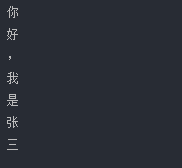
(2)使用字符数组读取:read(char[] cbuf),每次读取b的长度个字符到数组中,返回读取到的有效字符个数,读取到末尾时,返回-1 ,代码使用演示:

public class FileReaderDemo02 {public static void main(String[] args) throws IOException {//1.创建对象FileReader fr = new FileReader("my-io\\a.txt");//2.读取数据char[] chars = new char[2];int len; // 获取有效的字符//read(chars):读取数据,解码,强转三步合并了,把强转之后的字符放到数组当中//空参的read + 强转类型转换while((len = fr.read(chars)) != -1){// 把数组中的数据变成字符串再进行打印System.out.println(new String(chars,0,len));}//3.释放资源fr.close();}
}

3.3 字符输出流 Writer
java.io.Writer 抽象类是表示用于写出字符流的所有类的超类,将指定的字符信息写出到目的地。它定义了字节输出流的基本共性功能方法。
void write(int c)写入单个字符。void write(char[] cbuf)写入字符数组。abstract void write(char[] cbuf, int off, int len)写入字符数组的某一部分,off数组的开始索引,len写的字符个数。void write(String str)写入字符串。void write(String str, int off, int len)写入字符串的某一部分,off字符串的开始索引,len写的字符个数。void flush()刷新该流的缓冲。void close()关闭此流,但要先刷新它。
3.4 FileWriter类
java.io.FileWriter 类是写出字符到文件的便利类。构造时使用系统默认的字符编码和默认字节缓冲区。
3.4.1 构造方法
创建一个流对象时,必须传入一个文件路径,类似于FileOutputStream。
FileWriter(File file): 创建一个新的 FileWriter,给定要读取的File对象。FileWriter(String fileName): 创建一个新的 FileWriter,给定要读取的文件的名称。
代码示例:
public class FileWriterConstructor {public static void main(String[] args) throws IOException {// 使用File对象创建流对象File file = new File("a.txt");FileWriter fw = new FileWriter(file);// 使用文件名称创建流对象FileWriter fw = new FileWriter("b.txt");}
}
3.4.2 基本写出数据
写出字符:write(int b) 方法,每次可以写出一个字符数据,代码使用演示:
public class FWWrite {public static void main(String[] args) throws IOException {// 使用文件名称创建流对象FileWriter fw = new FileWriter("fw.txt"); // 写出数据fw.write(97); // 写出第1个字符fw.write('b'); // 写出第2个字符fw.write('C'); // 写出第3个字符fw.write(30000); // 写出第4个字符,中文编码表中30000对应一个汉字。/*【注意】关闭资源时,与FileOutputStream不同。如果不关闭,数据只是保存到缓冲区,并未保存到文件。*/// fw.close();}
}
输出结果:
abC田
- 虽然参数为int类型四个字节,但是只会保留一个字符的信息写出。
- 未调用close方法,数据只是保存到了缓冲区,并未写出到文件中。
3.4.3 关闭和刷新
因为内置缓冲区的原因,如果不关闭输出流,无法写出字符到文件中。但是关闭的流对象,是无法继续写出数据的。如果既想写出数据,又想继续使用流,就需要flush 方法了。
flush:刷新缓冲区,流对象可以继续使用。close:先刷新缓冲区,然后通知系统释放资源,流对象不可以再被使用了。
代码使用演示:
public class FWWrite {public static void main(String[] args) throws IOException {// 使用文件名称创建流对象FileWriter fw = new FileWriter("fw.txt");// 写出数据,通过flushfw.write('刷'); // 写出第1个字符fw.flush();fw.write('新'); // 继续写出第2个字符,写出成功fw.flush();// 写出数据,通过closefw.write('关'); // 写出第1个字符fw.close();fw.write('闭'); // 继续写出第2个字符,【报错】java.io.IOException: Stream closedfw.close();}
}
即便是flush方法写出了数据,操作的最后还是要调用close方法,释放系统资源。
3.4.4 写出其他数据
第一步:创建对象public FileWriter(File file) 创建字符输出流关联本地文件public FileWriter(String pathname) 创建字符输出流关联本地文件public FileWriter(File file, boolean append) 创建字符输出流关联本地文件,续写public FileWriter(String pathname, boolean append) 创建字符输出流关联本地文件,续写
第二步:读取数据void write(int c) 写出一个字符void write(String str) 写出一个字符串void write(String str, int off, int len) 写出一个字符串的一部分void write(char[] cbuf) 写出一个字符数组void write(char[] cbuf, int off, int len) 写出字符数组的一部分
第三步:释放资源public void close() 释放资源/关流
(1)写出字符数组 :write(char[] cbuf) 和 write(char[] cbuf, int off, int len) ,每次可以写出字符数组中的数据,用法类似FileOutputStream,代码使用演示:
public class FileWriterDemo01 {public static void main(String[] args) throws IOException {// 创建流对象并开启续写FileWriter fw = new FileWriter("my-io\\a.txt",true);//fw.write(25105);//fw.write("你好威啊???");char[] chars = {'a','b','c','我'};fw.write(chars);fw.close();}
}

(2)写出字符串:write(String str) 和 write(String str, int off, int len) ,每次可以写出字符串中的数据,更为方便,代码使用演示:
public class FileWriterDemo03 {public static void main(String[] args) throws IOException {// 创建流对象,未开启续写FileWriter fw = new FileWriter("my-io\\a.txt");fw.write("我的同学各个都很厉害");fw.write("说话声音很好听");fw.flush();fw.write("都是人才");fw.write("超爱这里哟");fw.close();}
}

(3)续写和换行:操作类似于FileOutputStream。
public class FileWriterDemo03 {public static void main(String[] args) throws IOException {// 使用文件名称创建流对象,可以续写数据FileWriter fw = new FileWriter("my-io\\a.txt",true);// 写出字符串fw.write("你好");// 写出换行fw.write("\r\n");// 写出字符串fw.write("我是张三");// 关闭资源fw.close();}
}

4、IO异常的处理
4.1 JDK7前处理
之前的入门练习,我们一直把异常抛出,而实际开发中并不能这样处理,建议使用try...catch...finally 代码块,处理异常部分,代码使用演示:
public class HandleException1 {public static void main(String[] args) {// 声明变量FileWriter fw = null;try {//创建流对象fw = new FileWriter("fw.txt");// 写出数据fw.write("我是张三"); } catch (IOException e) {e.printStackTrace();} finally {try {if (fw != null) {fw.close();}} catch (IOException e) {e.printStackTrace();}}}
}
4.2 JDK7的处理
还可以使用JDK7优化后的try-with-resource 语句,该语句确保了每个资源在语句结束时关闭。所谓的资源(resource)是指在程序完成后,必须关闭的对象。
格式:
try (创建流对象语句,如果多个,使用';'隔开) {// 读写数据
} catch (IOException e) {e.printStackTrace();
}
代码使用演示:
public class HandleException2 {public static void main(String[] args) {// 创建流对象try ( FileWriter fw = new FileWriter("fw.txt"); ) {// 写出数据fw.write("我是张三");} catch (IOException e) {e.printStackTrace();}}
}
4.3 JDK9的改进
JDK9中try-with-resource 的改进,对于引入对象的方式,支持的更加简洁。被引入的对象,同样可以自动关闭,无需手动close,我们来了解一下格式。
改进前格式:
// 被final修饰的对象
final Resource resource1 = new Resource("resource1");
// 普通对象
Resource resource2 = new Resource("resource2");
// 引入方式:创建新的变量保存
try (Resource r1 = resource1;Resource r2 = resource2) {// 使用对象
}
改进后格式:
// 被final修饰的对象
final Resource resource1 = new Resource("resource1");
// 普通对象
Resource resource2 = new Resource("resource2");// 引入方式:直接引入
try (resource1; resource2) {// 使用对象
}
改进后,代码使用演示:
public class TryDemo {public static void main(String[] args) throws IOException {// 创建流对象final FileReader fr = new FileReader("in.txt");FileWriter fw = new FileWriter("out.txt");// 引入到try中try (fr; fw) {// 定义变量int b;// 读取数据while ((b = fr.read())!=-1) {// 写出数据fw.write(b);}} catch (IOException e) {e.printStackTrace();}}
}
5、阶段练习
5.1 拷贝文件夹
需求:拷贝一个文件夹,考虑子文件夹。原文件夹目录结构如下:
─src│ aaa.txt│├─bbb│ │ bbb.txt│ │ bbb.xls│ ││ └─ccc│ ccc.txt│ ccc.xlsx│└─wwwwww.pptx
代码实现:
public class Test01 {public static void main(String[] args) throws IOException {//1.创建对象表示数据源File src = new File("D:\\aaa\\src");//2.创建对象表示目的地File dest = new File("D:\\aaa\\dest");//3.调用方法开始拷贝copydir(src,dest);}/*** 作用:拷贝文件夹* @param src 数据源* @param dest 目的地*/private static void copydir(File src, File dest) throws IOException {dest.mkdirs();//递归//1.进入数据源File[] files = src.listFiles();//2.遍历数组for (File file : files) {if(file.isFile()){//3.判断文件,拷贝FileInputStream fis = new FileInputStream(file);FileOutputStream fos = new FileOutputStream(new File(dest,file.getName()));byte[] bytes = new byte[1024];int len;while((len = fis.read(bytes)) != -1){fos.write(bytes,0,len);}fos.close();fis.close();}else {//4.判断文件夹,递归copydir(file, new File(dest,file.getName()));}}}
}
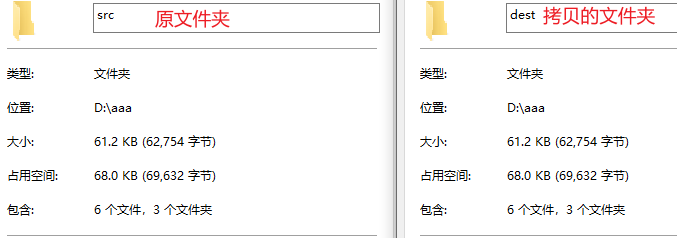
5.2 文件加密
需求:为了保证文件的安全性,就需要对原始文件进行加密存储,再使用的时候再对其进行解密处理。
加密原理:对原始文件中的每一个字节数据进行更改,然后将更改以后的数据存储到新的文件中。
解密原理:读取加密之后的文件,按照加密的规则反向操作,变成原始文件。使用异或解决,异或一次加密,再异或一次解密。
^ : 异或两边相同:false两边不同:true
public class Test02 {public static void main(String[] args) throws IOException {//加密encryptionAndReduction(new File("D:\\aaa\\src\\pic.jpg"),new File("D:\\aaa\\src\\secret.png"));//解密encryptionAndReduction(new File("D:\\aaa\\src\\secret.png"),new File("D:\\aaa\\src\\pic1.jpg"));}public static void encryptionAndReduction(File src, File dest) throws IOException {FileInputStream fis = new FileInputStream(src);FileOutputStream fos = new FileOutputStream(dest);int b;while ((b = fis.read()) != -1) {fos.write(b ^ 2);}//4.释放资源fos.close();fis.close();}
}
加密

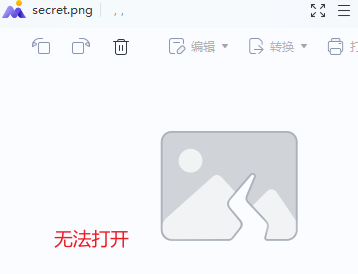
解密

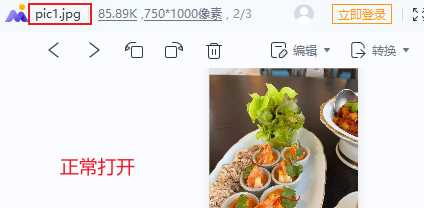
5.3 数字排序
文本文件中有以下的数据:
2-1-9-4-7-8
将文件中的数据进行排序,变成以下的数据:
1-2-4-7-8-9
实现方式一:

public class Test03 {public static void main(String[] args) throws IOException {//1.读取数据FileReader fr = new FileReader("my-io\\a.txt");StringBuilder sb = new StringBuilder();int ch;while((ch = fr.read()) != -1){sb.append((char)ch);}fr.close();System.out.println(sb);//2.排序String str = sb.toString();String[] arrStr = str.split("-");//2-1-9-4-7-8ArrayList<Integer> list = new ArrayList<>();for (String s : arrStr) {int i = Integer.parseInt(s);list.add(i);}Collections.sort(list);System.out.println(list);//3.写出FileWriter fw = new FileWriter("my-io\\a.txt");for (int i = 0; i < list.size(); i++) {if(i == list.size() - 1){fw.write(list.get(i) + "");}else{fw.write(list.get(i) + "-");}}fw.close();}
}


实现方式二:

public class Test04 {public static void main(String[] args) throws IOException {//1.读取数据FileReader fr = new FileReader("my-io\\a.txt");StringBuilder sb = new StringBuilder();int ch;while((ch = fr.read()) != -1){sb.append((char)ch);}fr.close();System.out.println(sb);//2.排序Integer[] arr = Arrays.stream(sb.toString().split("-")).map(Integer::parseInt).sorted().toArray(Integer[]::new);//3.写出FileWriter fw = new FileWriter("my-io\\a.txt");String s = Arrays.toString(arr).replace(", ","-");String result = s.substring(1, s.length() - 1);fw.write(result);fw.close();}
}


高级流
1、缓冲流
上面是一些基本的流,作为IO流的入门,接下来要学习一些更强大的流。比如能够高效读写的缓冲流,能够转换编码的转换流,能够持久化存储对象的序列化流等等。这些功能更为强大的流,都是在基本的流对象基础之上创建而来的,相当于是对基本流对象的一种增强。
1.1 概述
缓冲流,也叫高效流,是对4个基本的FileXxx 流的增强,所以也是4个流,按照数据类型分类:
- 字节缓冲流:
BufferedInputStream,BufferedOutputStream - 字符缓冲流:
BufferedReader,BufferedWriter
缓冲流的基本原理,是在创建流对象时,会创建一个内置的默认大小的缓冲区数组,通过缓冲区读写,减少系统IO次数,从而提高读写的效率。
1.2 字节缓冲流
1.2.1 构造方法
public BufferedInputStream(InputStream in):创建一个 新的缓冲输入流。public BufferedOutputStream(OutputStream out): 创建一个新的缓冲输出流。
构造举例,代码如下:
// 创建字节缓冲输入流
BufferedInputStream bis = new BufferedInputStream(new FileInputStream("bis.txt"));
// 创建字节缓冲输出流
BufferedOutputStream bos = new BufferedOutputStream(new FileOutputStream("bos.txt"));
1.2.2 效率测试
查询API,缓冲流读写方法与基本的流是一致的,我们通过复制大文件(375MB),测试它的效率。
(1)基本流,代码如下:
public class BufferedDemo {public static void main(String[] args) throws FileNotFoundException {// 记录开始时间long start = System.currentTimeMillis();// 创建流对象try (FileInputStream fis = new FileInputStream("jdk9.exe");FileOutputStream fos = new FileOutputStream("copy.exe")){// 读写数据int b;while ((b = fis.read()) != -1) {fos.write(b);}} catch (IOException e) {e.printStackTrace();}// 记录结束时间long end = System.currentTimeMillis();System.out.println("普通流复制时间:"+(end - start)+" 毫秒");}
}十几分钟过去了...
(2)缓冲流,代码如下:
public class BufferedDemo {public static void main(String[] args) throws FileNotFoundException {// 记录开始时间long start = System.currentTimeMillis();// 创建流对象try (BufferedInputStream bis = new BufferedInputStream(new FileInputStream("jdk9.exe"));BufferedOutputStream bos = new BufferedOutputStream(new FileOutputStream("copy.exe"));){// 读写数据int b;while ((b = bis.read()) != -1) {bos.write(b);}} catch (IOException e) {e.printStackTrace();}// 记录结束时间long end = System.currentTimeMillis();System.out.println("缓冲流复制时间:"+(end - start)+" 毫秒");}
}缓冲流复制时间:8016 毫秒
如何更快呢?使用数组的方式,代码如下:
public class BufferedDemo {public static void main(String[] args) throws FileNotFoundException {// 记录开始时间long start = System.currentTimeMillis();// 创建流对象try (BufferedInputStream bis = new BufferedInputStream(new FileInputStream("jdk9.exe"));BufferedOutputStream bos = new BufferedOutputStream(new FileOutputStream("copy.exe"));){// 读写数据int len;byte[] bytes = new byte[8*1024];while ((len = bis.read(bytes)) != -1) {bos.write(bytes, 0 , len);}} catch (IOException e) {e.printStackTrace();}// 记录结束时间long end = System.currentTimeMillis();System.out.println("缓冲流使用数组复制时间:"+(end - start)+" 毫秒");}
}
缓冲流使用数组复制时间:666 毫秒
1.3 字符缓冲流
1.3.1 构造方法
public BufferedReader(Reader in):创建一个 新的缓冲输入流。public BufferedWriter(Writer out): 创建一个新的缓冲输出流。
代码示例:
// 创建字符缓冲输入流
BufferedReader br = new BufferedReader(new FileReader("br.txt"));
// 创建字符缓冲输出流
BufferedWriter bw = new BufferedWriter(new FileWriter("bw.txt"));
1.3.2 特有方法
字符缓冲流的基本方法与普通字符流调用方式一致,不再阐述,我们来看它们具备的特有方法。
- BufferedReader:
public String readLine(): 读一行文字。 - BufferedWriter:
public void newLine(): 写一行行分隔符,由系统属性定义符号。
(1)readLine方法在读取的时候,一次读一整行,遇到回车换行结束,但是不会把回车换行读到内存当中,代码示例:

public class BufferedStreamDemo03 {public static void main(String[] args) throws IOException {//1.创建字符缓冲输入流的对象BufferedReader br = new BufferedReader(new FileReader("my-io\\a.txt"));//2.读取数据/*String line1 = br.readLine();System.out.println(line1);String line2 = br.readLine();System.out.println(line2);*/String line;while ((( line = br.readLine()) != null)){System.out.println(line);}//3.释放资源br.close();}
}

(2)newLine方法演示,代码如下:
public class BufferedStreamDemo04 {public static void main(String[] args) throws IOException {//1.创建字符缓冲输出流的对象BufferedWriter bw = new BufferedWriter(new FileWriter("my-io/b.txt",true));//2.写出数据bw.write("你好");bw.newLine();bw.write("我是张三");bw.newLine();//3.释放资源bw.close();}
}

1.4 练习-文本排序
需求:将文本信息恢复顺序
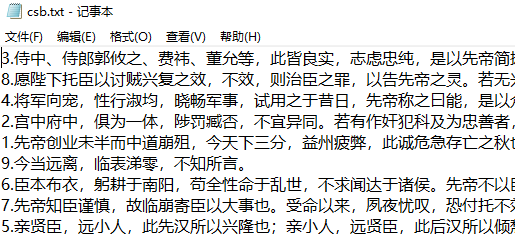
分析:
- 逐行读取文本信息。
- 把读取到的文本存储到集合中
- 对集合中的文本进行排序
- 遍历集合,按顺序,写出文本信息。
实现方式一:
public class Test06Case01 {public static void main(String[] args) throws IOException {//1.读取数据BufferedReader br = new BufferedReader(new FileReader("my-io\\csb.txt"));String line;ArrayList<String> list = new ArrayList<>();while((line = br.readLine()) != null){list.add(line);}br.close();//2.排序//排序规则:按照每一行前面的序号进行排列Collections.sort(list, new Comparator<String>() {@Overridepublic int compare(String o1, String o2) {//获取o1和o2的序号int i1 = Integer.parseInt(o1.split("\\.")[0]);int i2 = Integer.parseInt(o2.split("\\.")[0]);return i1 - i2;}});//3.写出BufferedWriter bw = new BufferedWriter(new FileWriter("my-io\\csb-result.txt"));for (String str : list) {bw.write(str);bw.newLine();}bw.close();}
}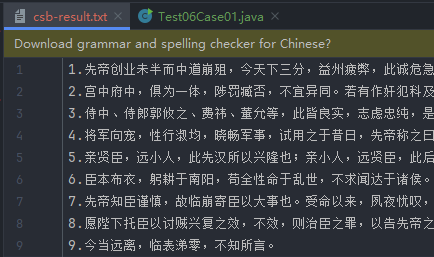
实现方式二:
public class Test06Case02 {public static void main(String[] args) throws IOException {//1.读取数据BufferedReader br = new BufferedReader(new FileReader("my-io\\csb.txt"));String line;TreeMap<Integer,String> tm = new TreeMap<>();while((line = br.readLine()) != null){String[] arr = line.split("\\.");//0:序号 1 :内容tm.put(Integer.parseInt(arr[0]),line);}br.close();//2.写出数据BufferedWriter bw = new BufferedWriter(new FileWriter("my-io\\csb-result2.txt"));Set<Map.Entry<Integer, String>> entries = tm.entrySet();for (Map.Entry<Integer, String> entry : entries) {String value = entry.getValue();bw.write(value);bw.newLine();}bw.close();}
}
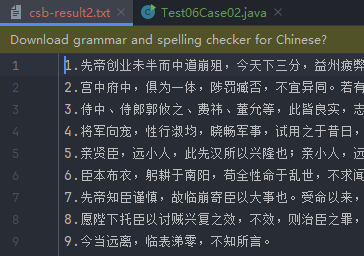
1.5 练习-程序运行次数限制
实现一个验证程序运行次数的小程序,要求如下:
1.当程序运行超过3次时给出提示:本软件只能免费使用3次,欢迎您注册会员后继续使用~
2.程序运行演示如下:第一次运行控制台输出: 欢迎使用本软件,第1次使用免费~第二次运行控制台输出: 欢迎使用本软件,第2次使用免费~第三次运行控制台输出: 欢迎使用本软件,第3次使用免费~第四次及之后运行控制台输出:本软件只能免费使用3次,欢迎您注册会员后继续使用~
代码实现:
public class Test07 {public static void main(String[] args) throws IOException {//1.把文件中的数字读取到内存中//创建IO流的原则:随用随创建,什么时候不用什么时候关闭BufferedReader br = new BufferedReader(new FileReader("my-io\\count.txt"));String line = br.readLine();br.close(); // 读完数据就关闭int count = Integer.parseInt(line);//表示当前软件又运行了一次count++;//1//2.判断if(count <= 3 && count >= 0){System.out.println("欢迎使用本软件,第"+count+"次使用免费~");}else{System.out.println("本软件只能免费使用3次,欢迎您注册会员后继续使用~");}BufferedWriter bw = new BufferedWriter(new FileWriter("my-io\\count.txt"));//3.把当前自增之后的count写出到文件当中bw.write(count + ""); // 转成字符串bw.close();}
}

第一次运行


第二次运行


第三次运行


第四次运行


2、转换流
2.1 字符编码和字符集
GBK:中文2个字节,英文一个字节
UTF-8:中文3个字节,英文一个字节(UTF-8不是字符集,Unicode才是字符集,UTF-8只是Unicode字符集下的一种编码方式)
2.1.1 字符编码
编码:字符(能看懂的)–字节(看不懂的)
解码:字节(看不懂的)–>字符(能看懂的)
字符编码Character Encoding : 就是一套自然语言的字符与二进制数之间的对应规则。
编码表:生活中文字和计算机中二进制的对应规则
2.1.2 字符集
- 字符集
Charset:也叫编码表。是一个系统支持的所有字符的集合,包括各国家文字、标点符号、图形符号、数字等。
计算机要准确的存储和识别各种字符集符号,需要进行字符编码,一套字符集必然至少有一套字符编码。常见字符集有ASCII字符集、GBK字符集、Unicode字符集等。

-
ASCII字符集 :
- ASCII用于显示现代英语,主要包括控制字符(回车键、退格、换行键等)和可显示字符(英文大小写字符、阿拉伯数字和西文符号)。
- 基本的ASCII字符集,使用7位(bits)表示一个字符,共128字符。ASCII的扩展字符集使用8位(bits)表示一个字符,共256字符,方便支持欧洲常用字符。
-
GBxxx字符集:
- GB2312:简体中文码表。一个小于127的字符的意义与原来相同,但两个大于127的字符连在一起时,就表示一个汉字,这样大约可以组合了包含7000多个简体汉字,此外数学符号、罗马希腊的字母、日文的假名们都编进去了,连在ASCII里本来就有的数字、标点、字母都统统重新编了两个字节长的编码,这就是常说的"全角"字符,而原来在127号以下的那些就叫"半角"字符了。
- GBK:最常用的中文码表。是在GB2312标准基础上的扩展规范,使用了双字节编码方案,共收录了21003个汉字,完全兼容GB2312标准,同时支持繁体汉字以及日韩汉字等。
- GB18030:最新的中文码表。收录汉字70244个,采用多字节编码,每个字可以由1个、2个或4个字节组成。支持中国国内少数民族的文字,同时支持繁体汉字以及日韩汉字等。
-
Unicode字符集 :
-
它最多使用4个字节的数字来表达每个字母、符号,或者文字。有三种编码方案,UTF-8、UTF-16和UTF-32。最为常用的UTF-8编码。
-
UTF-8编码,可以用来表示Unicode标准中任何字符,它是电子邮件、网页及其他存储或传送文字的应用中,优先采用的编码。它使用一至四个字节为每个字符编码,编码规则:
- 128个US-ASCII字符,只需一个字节编码。
- 拉丁文等字符,需要二个字节编码。
- 大部分常用字(含中文),使用三个字节编码。
- 其他极少使用的Unicode辅助字符,使用四字节编码。
-
2.2 编码引出的问题
在IDEA中,使用FileReader 读取项目中的文本文件。由于IDEA的设置,都是默认的UTF-8编码,所以没有任何问题。但是,当读取Windows系统中创建的文本文件时,由于Windows系统的默认是GBK编码,就会出现乱码。
public class ReaderDemo {public static void main(String[] args) throws IOException {FileReader fileReader = new FileReader("E:\\File_GBK.txt");int read;while ((read = fileReader.read()) != -1) {System.out.print((char)read);}fileReader.close();}
}
输出结果:
���
那么如何读取GBK编码的文件呢?
2.3 InputStreamReader类
注意:这种做法是JDK11之前的,JDK11及之后使用FileReader指定字符集。
转换流java.io.InputStreamReader,是Reader的子类,是从字节流到字符流的桥梁。它读取字节,并使用指定的字符集将其解码为字符。它的字符集可以由名称指定,也可以接受平台的默认字符集。
2.3.1 构造方法
InputStreamReader(InputStream in): 创建一个使用默认字符集的字符流。InputStreamReader(InputStream in, String charsetName): 创建一个指定字符集的字符流。
代码示例:
InputStreamReader isr = new InputStreamReader(new FileInputStream("in.txt"));
InputStreamReader isr2 = new InputStreamReader(new FileInputStream("in.txt") , "GBK");
2.3.2 指定编码读取
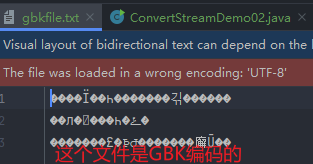
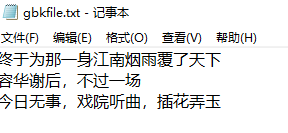

JDK11之前的做法:使用InputStreamReader
public class ConvertStreamDemo02 {public static void main(String[] args) throws IOException {//1.创建对象并指定字符编码(了解)InputStreamReader isr = new InputStreamReader(new FileInputStream("my-io\\gbkfile.txt"),"GBK");//2.读取数据int ch;while ((ch = isr.read()) != -1){System.out.print((char)ch);}//3.释放资源isr.close();}
}

JDK11及之后的做法:使用FileReader
public class ConvertStreamDemo02 {public static void main(String[] args) throws IOException {// JDK11之后的方法FileReader fr = new FileReader("my-io\\gbkfile.txt", Charset.forName("GBK"));//2.读取数据int ch2;while ((ch2 = fr.read()) != -1){System.out.print((char)ch2);}//3.释放资源fr.close();}
}

2.4 OutputStreamWriter类
注意:这种做法是JDK11之前的,JDK11及之后使用FileWriter指定字符集。
转换流java.io.OutputStreamWriter ,是Writer的子类,是从字符流到字节流的桥梁。使用指定的字符集将字符编码为字节。它的字符集可以由名称指定,也可以接受平台的默认字符集。
2.4.1 构造方法
OutputStreamWriter(OutputStream in):创建一个使用默认字符集的字符流。OutputStreamWriter(OutputStream in, String charsetName):创建一个指定字符集的字符流。
代码示例:
OutputStreamWriter isr = new OutputStreamWriter(new FileOutputStream("out.txt"));
OutputStreamWriter isr2 = new OutputStreamWriter(new FileOutputStream("out.txt") , "GBK");
2.4.2 指定编码写出
JDK11之前:使用OutputStreamWriter
public class ConvertStreamDemo03 {public static void main(String[] args) throws IOException {//1.创建转换流的对象(JDK11之前)OutputStreamWriter osw = new OutputStreamWriter(new FileOutputStream("my-io\\b.txt"),"GBK");//2.写出数据osw.write("你好你好");//3.释放资源osw.close();}
}
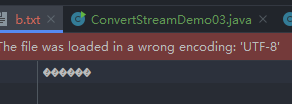


JDK11及之后:使用FileWriter
public class ConvertStreamDemo03 {public static void main(String[] args) throws IOException {FileWriter fw = new FileWriter("my-io\\c.txt", Charset.forName("GBK"));fw.write("你好你好");fw.close();}
}



2.5 练习-转换文件编码
将GBK编码的文本文件,转换为UTF-8编码的文本文件。
- 指定GBK编码的转换流,读取文本文件。
- 使用UTF-8编码的转换流,写出文本文件。
public class ConvertStreamDemo04 {public static void main(String[] args) throws IOException {//方法一:JDK11以前的方案InputStreamReader isr = new InputStreamReader(new FileInputStream("my-io\\gbkfile.txt"),"GBK");OutputStreamWriter osw = new OutputStreamWriter(new FileOutputStream("my-io\\utf8file.txt"),"UTF-8");int b;while((b = isr.read()) != -1){osw.write(b);}osw.close();isr.close();//方法二:JDK11及之后的方案FileReader fr = new FileReader("my-io\\gbkfile.txt", Charset.forName("GBK"));FileWriter fw = new FileWriter("my-io\\utf8file2.txt",Charset.forName("UTF-8"));int b2;while ((b2 = fr.read()) != -1){fw.write(b2);}fw.close();fr.close();}
}
2.6 练习-按行读取数据
利用字节流读取文件中的数据,每次读一整行,而且不能出现乱码,需要注意的是:
1.字节流在读取中文的时候,是会出现乱码的,但是字符流可以搞定
2.字节流里面是没有读一整行的方法的,只有字符缓冲流才能搞定
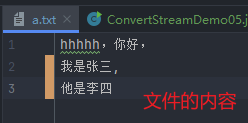

public class ConvertStreamDemo05 {public static void main(String[] args) throws IOException {BufferedReader br = new BufferedReader(new InputStreamReader(new FileInputStream("my-io\\a.txt")));String line;while ((line = br.readLine()) != null){System.out.println(line);}br.close();}
}

3、序列化流
3.1 概述
Java 提供了一种对象序列化的机制。用一个字节序列可以表示一个对象,该字节序列包含该对象的数据、对象的类型和对象中存储的属性等信息。字节序列写出到文件之后,相当于文件中持久保存了一个对象的信息。
反之,该字节序列还可以从文件中读取回来,重构对象,对它进行反序列化。对象的数据、对象的类型和对象中存储的数据信息,都可以用来在内存中创建对象。
3.2 ObjectOutputStream类
java.io.ObjectOutputStream 类,将Java对象的原始数据类型写出到文件,实现对象的持久存储。
3.2.1 构造方法
public ObjectOutputStream(OutputStream out) : 创建一个指定OutputStream的ObjectOutputStream,即把基本流变成高级流。
FileOutputStream fileOut = new FileOutputStream("employee.txt");
ObjectOutputStream out = new ObjectOutputStream(fileOut);
3.2.2 序列化操作
(1)一个对象要想序列化,必须满足两个条件:
- 该类必须实现
java.io.Serializable接口,Serializable是一个标记接口,不实现此接口的类将不会使任何状态序列化或反序列化,会抛出NotSerializableException。 - 该类的所有属性必须是可序列化的。如果有一个属性不需要可序列化的,则该属性必须注明是瞬态的,使用
transient关键字修饰。
public class Student implements Serializable {private String name;private int age;//transient:瞬态关键字//作用:不会把当前属性序列化到本地文件当中private transient String address;public Student() {}public Student(String name, int age, String address) {this.name = name;this.age = age;this.address = address;}public String getName() {return name;}public void setName(String name) {this.name = name;}public int getAge() {return age;}public void setAge(int age) {this.age = age;}public String getAddress() {return address;}public void setAddress(String address) {this.address = address;}public String toString() {return "Student{name = " + name + ", age = " + age + ", address = " + address + "}";}
}
(2)写出对象方法
public final void writeObject (Object obj):将指定的对象写出。
public class ObjectStreamDemo01 {public static void main(String[] args) throws IOException {//1.创建对象Student stu = new Student("zhangsan",23,"北京");//2.创建序列化流的对象/对象操作输出流ObjectOutputStream oos = new ObjectOutputStream(new FileOutputStream("my-io\\a.txt"));//3.写出数据oos.writeObject(stu);//4.释放资源oos.close();}
}

3.3 ObjectInputStream类
ObjectInputStream反序列化流,将之前使用ObjectOutputStream序列化的原始数据恢复为对象。
3.3.1 构造方法
public ObjectInputStream(InputStream in) : 创建一个指定InputStream的ObjectInputStream,即把基本流变成高级流。
3.3.2 反序列化操作
如果能找到一个对象的class文件,可以进行反序列化操作,调用ObjectInputStream读取对象的方法:
public final Object readObject () : 读取一个对象。
public class ObjectStreamDemo02 {public static void main(String[] args) throws IOException, ClassNotFoundException {//1.创建反序列化流的对象ObjectInputStream ois = new ObjectInputStream(new FileInputStream("my-io\\a.txt"));//2.读取数据Student o = (Student) ois.readObject();//3.打印对象System.out.println(o);//4.释放资源ois.close();}
}

对于JVM可以反序列化对象,它必须是能够找到class文件的类。如果找不到该类的class文件,则抛出一个 ClassNotFoundException 异常。
3.3.3 反序列化操作问题
当JVM反序列化对象时,能找到class文件,但是class文件在序列化对象之后,实体类进行了修改(比如修改了属性等),那么反序列化操作也会失败,抛出一个InvalidClassException异常。发生这个异常的原因如下:
- 该类的序列版本号与从流中读取的类描述符的版本号不匹配
- 该类包含未知数据类型
- 该类没有可访问的无参数构造方法
解决:
Serializable接口给需要序列化的类,提供了一个序列版本号。serialVersionUID该版本号的目的在于验证序列化的对象和对应类是否版本匹配。
idea可以自动设置版本号:
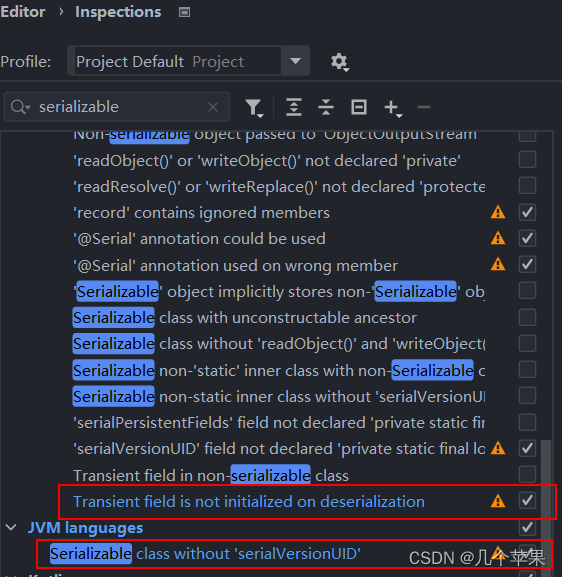


注意:注解@Serial在JDK14及以上才支持。
3.4 练习-序列化集合
需求:
- 将存有多个自定义对象的集合序列化操作,保存到
list.txt文件中。 - 反序列化
list.txt,并遍历集合,打印对象信息。
分析:
- 把若干学生对象 ,保存到集合中。
- 把集合序列化。
- 反序列化读取时,只需要读取一次,转换为集合类型。
- 遍历集合,可以打印所有的学生信息
代码实现:
public class Student implements Serializable {@Serialprivate static final long serialVersionUID = 8447688314497035445L;private String name;private int age;private String address;public Student() {}public Student(String name, int age, String address) {this.name = name;this.age = age;this.address = address;}public String getName() {return name;}public void setName(String name) {this.name = name;}public int getAge() {return age;}public void setAge(int age) {this.age = age;}public String getAddress() {return address;}public void setAddress(String address) {this.address = address;}public String toString() {return "Student{name = " + name + ", age = " + age + ", address = " + address + "}";}
}
(1)序列化
public class Test08 {public static void main(String[] args) throws IOException {//1.序列化多个对象Student s1 = new Student("老王", 23,"北京");Student s2 = new Student("老张", 22,"上海" );Student s3 = new Student("老李",20,"南京");ArrayList<Student> list = new ArrayList<>();list.add(s1);list.add(s2);list.add(s3);ObjectOutputStream oos = new ObjectOutputStream(new FileOutputStream("my-io\\a.txt"));oos.writeObject(list);oos.close();}
}

(2)反序列化
public class Test09 {public static void main(String[] args) throws IOException, ClassNotFoundException {//1.创建反序列化流的对象ObjectInputStream ois = new ObjectInputStream(new FileInputStream("my-io\\a.txt"));//2.读取数据ArrayList<Student> list = (ArrayList<Student>) ois.readObject();for (Student student : list) {System.out.println(student);}//3.释放资源ois.close();}
}

(3)序列化和反序列化合并
public class Test10 {public static void main(String[] args) throws Exception {// 创建 学生对象Student student = new Student("老王", 23,"北京");Student student2 = new Student("老张", 22,"上海" );Student student3 = new Student("老李",20,"南京");ArrayList<Student> arrayList = new ArrayList<>();arrayList.add(student);arrayList.add(student2);arrayList.add(student3);// 序列化操作serializ(arrayList);// 反序列化ObjectInputStream ois = new ObjectInputStream(new FileInputStream("my-io/list.txt"));// 读取对象,强转为ArrayList类型ArrayList<Student> list = (ArrayList<Student>)ois.readObject();for (Student s : list) {System.out.println(s);}//3.释放资源ois.close();}private static void serializ(ArrayList<Student> arrayList) throws Exception {// 创建 序列化流ObjectOutputStream oos = new ObjectOutputStream(new FileOutputStream("my-io/list.txt"));// 写出对象oos.writeObject(arrayList);// 释放资源oos.close();}
}


4、打印流
只有写,没有读。
4.1 概述
平时我们在控制台打印输出,是调用print方法和println方法完成的,这两个方法都来自于java.io.PrintStream类,该类能够方便地打印各种数据类型的值,是一种便捷的输出方式。
4.2 字节打印流PrintStream
4.2.1 构造方法
public PrintStream(String fileName) : 使用指定的文件名创建一个新的打印流。
代码示例:
PrintStream ps = new PrintStream("ps.txt");
4.2.2 改变打印流向
System.out就是PrintStream类型的,只不过它的流向是系统规定的,打印在控制台上。不过,既然是流对象,我们就可以玩一个"小把戏",改变它的流向。
public class PrintDemo {public static void main(String[] args) throws IOException {// 调用系统的打印流,控制台直接输出97System.out.println(97);// 创建打印流,指定文件的名称PrintStream ps = new PrintStream("ps.txt");// 设置系统的打印流流向,输出到ps.txtSystem.setOut(ps);// 调用系统的打印流,ps.txt中输出97System.out.println(97);}
}
4.2.3 字节打印流基本使用
构造方法:
public PrintStream(OutputStream/File/String) 关联字节输出流/文件/文件路径
public PrintStream(String fileName, Charset charset) 指定字符编码
public PrintStream(OutputStreamout, boolean autoFlush) 自动刷新
public PrintStream(OutputStream out, boolean autoFlush, String encoding) 指定字符编码且自动刷新
成员方法:
public void write(int b) 常规方法:规则跟之前一样,将指定的字节写出
public void println(Xxx xx) 特有方法:打印任意数据,自动刷新,自动换行
public void print(Xxx xx) 特有方法:打印任意数据,不换行
public void printf(String format, Object... args) 特有方法:带有占位符的打印语句,不换行
代码示例:
public class PrintStreamDemo01 {public static void main(String[] args) throws FileNotFoundException {//1.创建字节打印流的对象PrintStream ps = new PrintStream(new FileOutputStream("my-io\\a.txt"), true, Charset.forName("UTF-8"));//2.写出数据ps.println(97); //写出 + 自动刷新 + 自动换行ps.print(true);ps.println();ps.printf("%s爱上了%s","阿珍","阿强");//3.释放资源ps.close();}
}
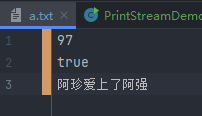
4.3 字符打印流
构造方法:
public PrintWriter(Write/File/String) 关联字节输出流/文件/文件路径
public PrintWriter(String fileName, Charset charset) 指定字符编码
public PrintWriter(Write, boolean autoFlush) 自动刷新
public PrintWriter(Write out, boolean autoFlush, String encoding) 指定字符编码且自动刷新
成员方法:
public void write(int b) 常规方法:规则跟之前一样,将指定的字节写出
public void println(Xxx xx) 特有方法:打印任意数据,自动刷新,自动换行
public void print(Xxx xx) 特有方法:打印任意数据,不换行
public void printf(String format, Object... args) 特有方法:带有占位符的打印语句,不换行
代码示例:
public class PrintStreamDemo03 {public static void main(String[] args) throws IOException {//1.创建字符打印流的对象PrintWriter pw = new PrintWriter(new FileWriter("my-io\\a.txt"),true);//2.写出数据pw.println("今天你终于叫我名字了,虽然叫错了,但是没关系,我马上改");pw.print("你好你好");pw.printf("%s爱上了%s","阿珍","阿强");//3.释放资源pw.close();}
}

5、压缩流和解压缩流
Java中只能识别zip格式的。
压缩流:负责压缩文件或者文件夹
解压缩流:负责把压缩包中的文件和文件夹解压出来
5.1 解压流 ZipInputStream
可以解压多级文件夹
public class ZipStreamDemo01 {public static void main(String[] args) throws IOException {//1.创建一个File表示要解压的压缩包File src = new File("D:\\aaa\\src.zip");//2.创建一个File表示解压的目的地File dest = new File("D:\\aaa\\dest");//调用方法unzip(src,dest);}//定义一个方法用来解压public static void unzip(File src,File dest) throws IOException {//解压的本质:把压缩包里面的每一个文件或者文件夹读取出来,按照层级拷贝到目的地当中//创建一个解压缩流用来读取压缩包中的数据ZipInputStream zip = new ZipInputStream(new FileInputStream(src));//要先获取到压缩包里面的每一个zipentry对象//表示当前在压缩包中获取到的文件或者文件夹ZipEntry entry;while((entry = zip.getNextEntry()) != null){System.out.println(entry);if(entry.isDirectory()){//文件夹:需要在目的地dest处创建一个同样的文件夹File file = new File(dest,entry.toString());file.mkdirs();}else{//文件:需要读取到压缩包中的文件,并把他存放到目的地dest文件夹中(按照层级目录进行存放)FileOutputStream fos = new FileOutputStream(new File(dest,entry.toString()));int b;while((b = zip.read()) != -1){//写到目的地fos.write(b);}fos.close();//表示在压缩包中的一个文件处理完毕了。zip.closeEntry();}}zip.close();}
}
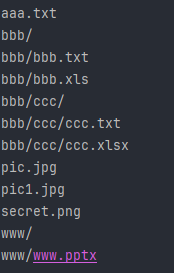
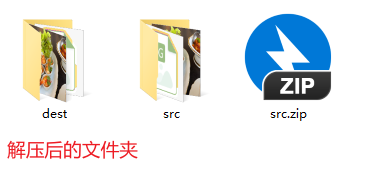
5.2 压缩流 ZipOutputStream
5.2.1 压缩单个文件
public class ZipStreamDemo02 {public static void main(String[] args) throws IOException {//1.创建File对象表示要压缩的文件File src = new File("D:\\aaa\\a.txt");//2.创建File对象表示压缩包的位置File dest = new File("D:\\aaa");//3.调用方法用来压缩toZip(src,dest);}/*** 压缩* @param src 表示要压缩的文件* @param dest 表示压缩包的位置*/public static void toZip(File src,File dest) throws IOException {//1.创建压缩流关联压缩包ZipOutputStream zos = new ZipOutputStream(new FileOutputStream(new File(dest,"a.zip")));//2.创建ZipEntry对象,表示压缩包里面的每一个文件和文件夹//参数:压缩包里面的路径ZipEntry entry = new ZipEntry("aaa\\bbb\\a.txt");//3.把ZipEntry对象放到压缩包当中zos.putNextEntry(entry);//4.把src文件中的数据写到压缩包当中FileInputStream fis = new FileInputStream(src);int b;while((b = fis.read()) != -1){zos.write(b);}zos.closeEntry();zos.close();}
}
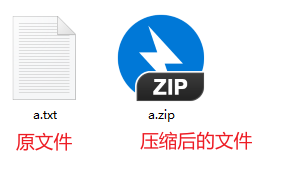
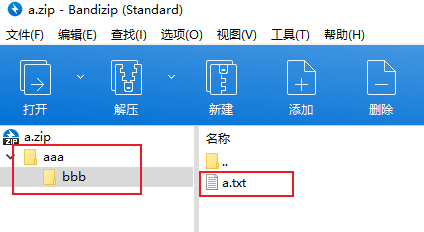
5.2.2 压缩多级文件夹
public class ZipStreamDemo03 {public static void main(String[] args) throws IOException {//1.创建File对象表示要压缩的文件夹File src = new File("D:\\aaa\\src");//2.创建File对象表示压缩包放在哪里(压缩包的父级路径)File destParent = src.getParentFile();//3.创建File对象表示压缩包的路径File dest = new File(destParent,src.getName() + ".zip");//4.创建压缩流关联压缩包ZipOutputStream zos = new ZipOutputStream(new FileOutputStream(dest));//5.获取src里面的每一个文件,变成ZipEntry对象,放入到压缩包当中toZip(src,zos,src.getName());//6.释放资源zos.close();}/*** 获取src里面的每一个文件,变成ZipEntry对象,放入到压缩包当中* @param src 数据源* @param zos 压缩流* @param name 压缩包内部的路径*/public static void toZip(File src, ZipOutputStream zos, String name) throws IOException {//1.进入src文件夹File[] files = src.listFiles();//2.遍历数组for (File file : files) {if(file.isFile()){//3.判断-文件,变成ZipEntry对象,放入到压缩包当中ZipEntry entry = new ZipEntry(name + "\\" + file.getName());zos.putNextEntry(entry);//读取文件中的数据,写到压缩包FileInputStream fis = new FileInputStream(file);int b;while((b = fis.read()) != -1){zos.write(b);}fis.close();zos.closeEntry();}else{//4.判断-文件夹,递归toZip(file,zos,name + "\\" + file.getName());}}}
}
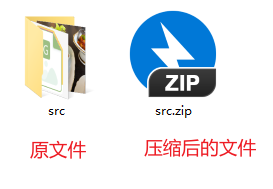
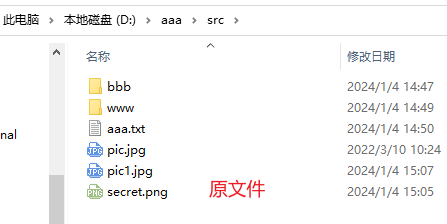
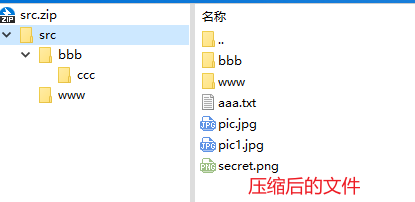
6、工具包 Commons-io
官网:https://commons.apache.org/
Commons是apache开源基金组织提供的工具包,里面有很多帮助我们提高开发效率的API,比如:
- StringUtils:字符串工具类
- NumberUtils:数字工具类
- ArrayUtils:数组工具类
- RandomUtils:随机数工具类
- DateUtils:日期工具类
- StopWatch:秒表工具类
- ClassUtils:反射工具类
- SystemUtils:系统工具类
- MapUtils:集合工具类
- Beanutils:bean工具类
- Commons-io:io的工具类
其中Commons-io是apache开源基金组织提供的一组有关IO操作的开源工具包,用于提高IO流的开发效率。
官网:https://commons.apache.org/proper/commons-io/
文档:https://commons.apache.org/proper/commons-io/apidocs/index.html
使用方式:
- 新建lib文件夹
- 把第三方jar包粘贴到文件夹中
- 右键点击add as a library

Commons-io中的常用方法:
FileUtils类static void copyFile(File srcFile, File destFile) 复制文件static void copyDirectory(File srcDir, File destDir) 复制文件夹static void copyDirectoryToDirectory(File srcDir, File destDir) 复制文件夹static void deleteDirectory(File directory) 删除文件夹static void cleanDirectory(File directory) 清空文件夹static String readFileToString(File file, Charset encoding) 读取文件中的数据变成成字符串static void write(File file, CharSequence data, String encoding) 写出数据IOUtils类public static int copy(InputStream input, OutputStream output) 复制文件public static int copyLarge(Reader input, Writer output) 复制大文件public static String readLines(Reader input) 读取数据public static void write(String data, OutputStream output) 写出数据
代码示例:
public class CommonsIODemo {public static void main(String[] args) throws IOException {// 文件复制File src = new File("my-io\\a.txt");File dest = new File("my-io\\copy.txt");FileUtils.copyFile(src,dest);// 文件夹复制File src2 = new File("D:\\aaa\\src");File dest2 = new File("D:\\aaa\\bbb");FileUtils.copyDirectoryToDirectory(src2,dest2);// 清除文件夹D:\aaa\bbb的内容File src3 = new File("D:\\aaa\\bbb");FileUtils.cleanDirectory(src3);}
}
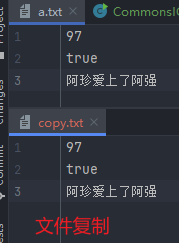
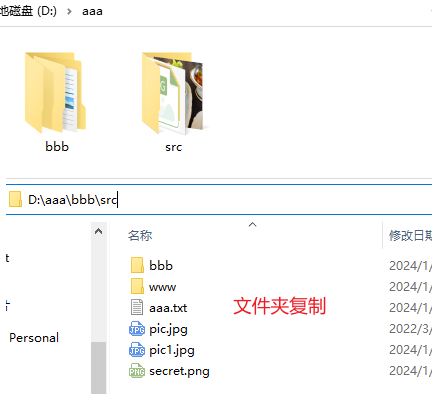

7、工具包 Hutool
官网:https://hutool.cn/
API文档:https://plus.hutool.cn/apidocs/
中文使用文档:https://doc.hutool.cn/pages/index/
Commons是国人开发的开源工具包,里面有很多帮助我们提高开发效率的API,比如:
- DateUtil:日期时间工具类
- TimeInterval:计时器工具类
- StrUtil:字符串工具类
- HexUtil:16进制工具类
- HashUtil:Hash算法类
- ObjectUtil:对象工具类
- ReflectUtil:反射工具类
- TypeUtil:泛型类型工具类
- PageUtil:分页工具类
- NumberUtil:数字工具类
使用方式:
- 新建lib文件夹
- 把第三方jar包粘贴到文件夹中
- 右键点击add as a library
常用方法:
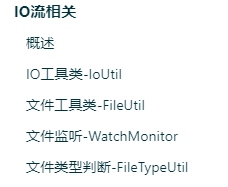
FileUtil类:file:根据参数创建一个file对象touch:创建文件,如果父目录不存在也自动创建writeLines:把集合中的数据写出到文件中,覆盖模式。appendLines:把集合中的数据写出到文件中,续写模式。readLines:指定字符编码,把文件中的数据,读到集合中。readUtf8Lines:按照UTF-8的形式,把文件中的数据,读到集合中copy:拷贝文件或者文件夹
代码示例:
public class HuToolDemo {public static void main(String[] args) {// 拼接路径创建File对象File file1 = FileUtil.file("D:\\", "aaa", "bbb", "a.txt");System.out.println(file1);//D:\aaa\bbb\a.txt// touch创建文件,如果父目录不存在也自动创建File touch = FileUtil.touch(file1);System.out.println(touch);}
}


public class HuToolDemo {public static void main(String[] args) {ArrayList<String> list = new ArrayList<>();list.add("aaa");list.add("aaa");list.add("aaa");// writeLines把集合中的数据写出到文件中,覆盖模式File file2 = FileUtil.writeLines(list, "D:\\aaa\\a.txt", "UTF-8");System.out.println(file2);// appendLines把集合中的数据写出到文件中,续写模式File file3 = FileUtil.appendLines(list, "D:\\aaa\\a.txt", "UTF-8");System.out.println(file3);// readLines指定字符编码,把文件中的数据,读到集合中List<String> list2 = FileUtil.readLines("D:\\aaa\\a.txt", "UTF-8");System.out.println(list2);}
}

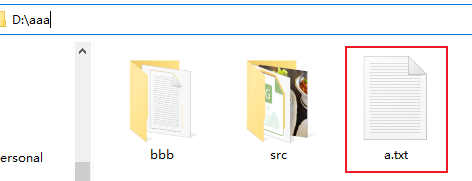

8、配置文件操作IO流
创建一个空的配置文件 a.properties
8.1 向配置文件中存放数据
Properties集合+IO流:Properties跟IO流结合的操作,向a.properties中写入集合Properties中的数据
public class Test11 {public static void main(String[] args) throws IOException {//1.创建集合Properties prop = new Properties();//2.添加数据prop.put("aaa","bbb");prop.put("bbb","ccc");prop.put("ddd","eee");prop.put("fff","iii");//3.把集合中的数据以键值对的形式写到本地文件当中// 方法一:/*FileOutputStream fos = new FileOutputStream("my-io\\a.properties");prop.store(fos,"test");fos.close();*/// 方法二:BufferedWriter bw = new BufferedWriter(new FileWriter("my-io\\a.properties"));Set<Map.Entry<Object, Object>> entries = prop.entrySet();for (Map.Entry<Object, Object> entry : entries) {Object key = entry.getKey();Object value = entry.getValue();bw.write(key + "=" + value);bw.newLine();}bw.close();}
}
方法一:
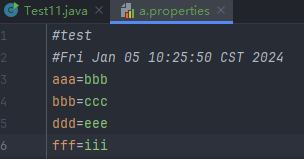
方法二:
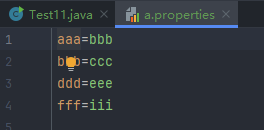
8.2 读取配置文件的数据
Properties集合+IO流:读取配置文件a.properties中的数据,存放到Properties集合中并打印出来
public class Test12 {public static void main(String[] args) throws IOException {//1.创建集合Properties prop = new Properties();//2.读取本地Properties文件里面的数据FileInputStream fis = new FileInputStream("my-io\\a.properties");prop.load(fis);fis.close();//3.打印集合System.out.println(prop);}
}

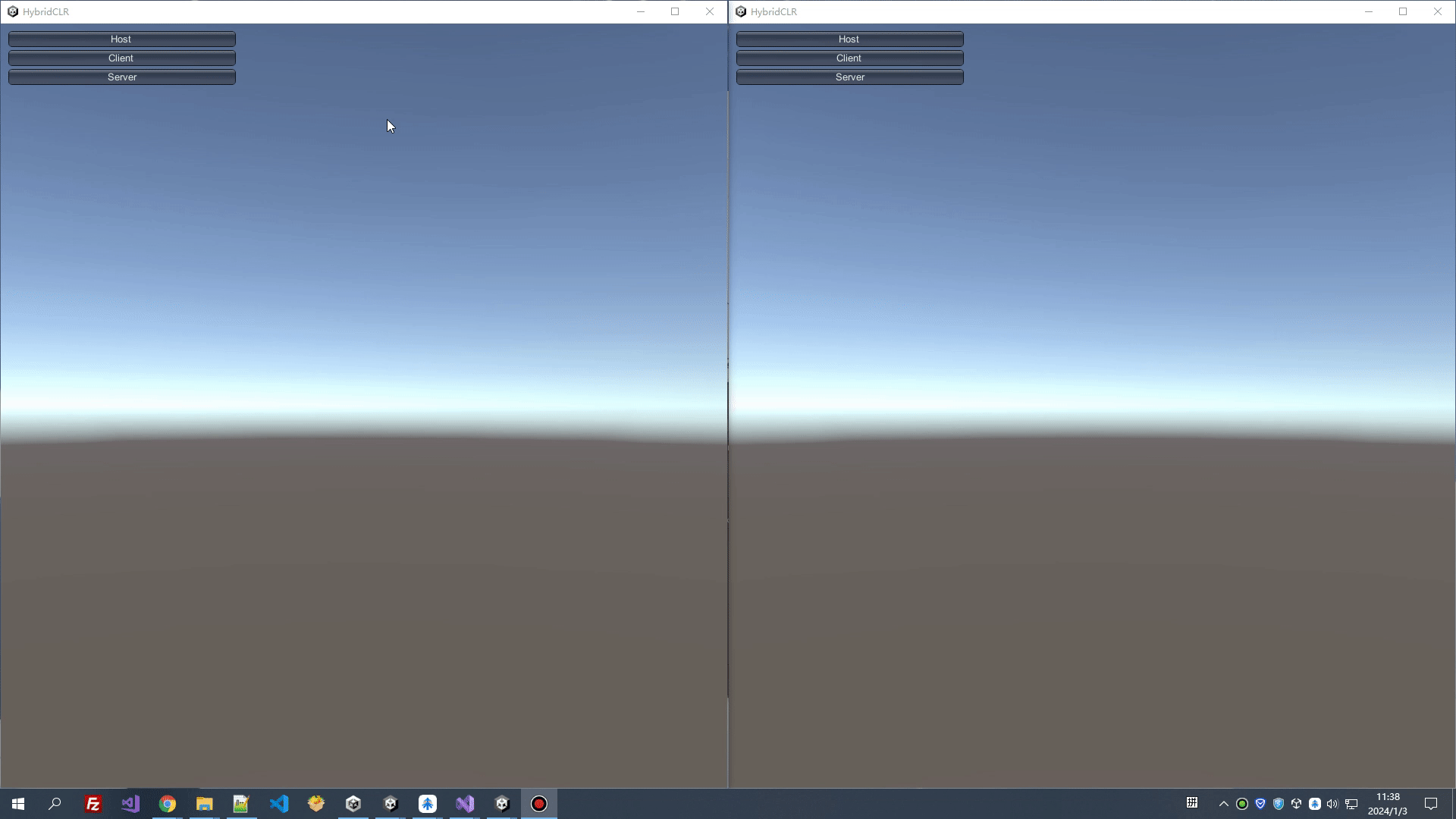



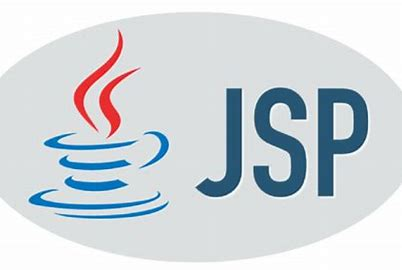


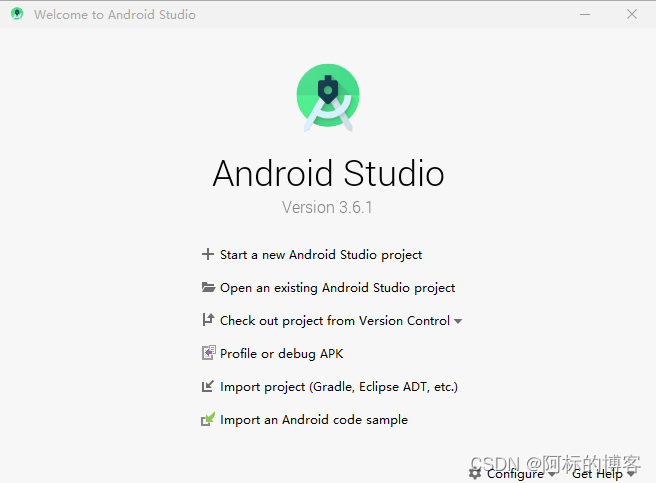

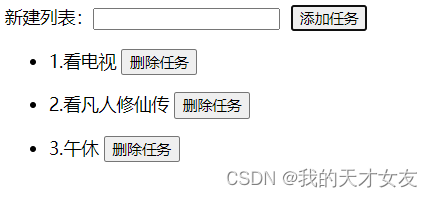
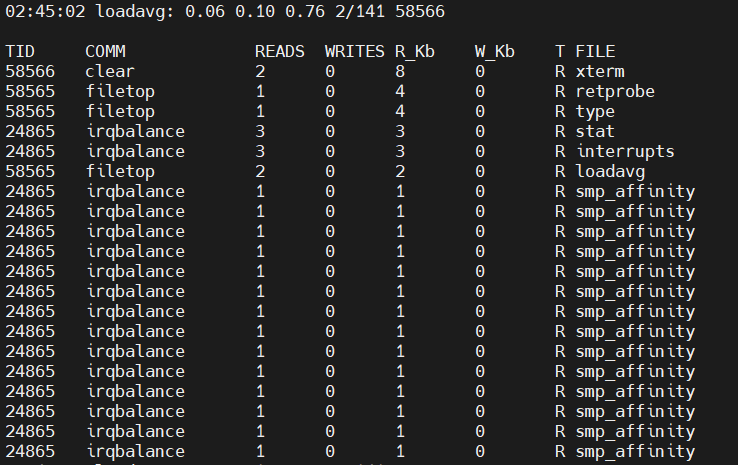

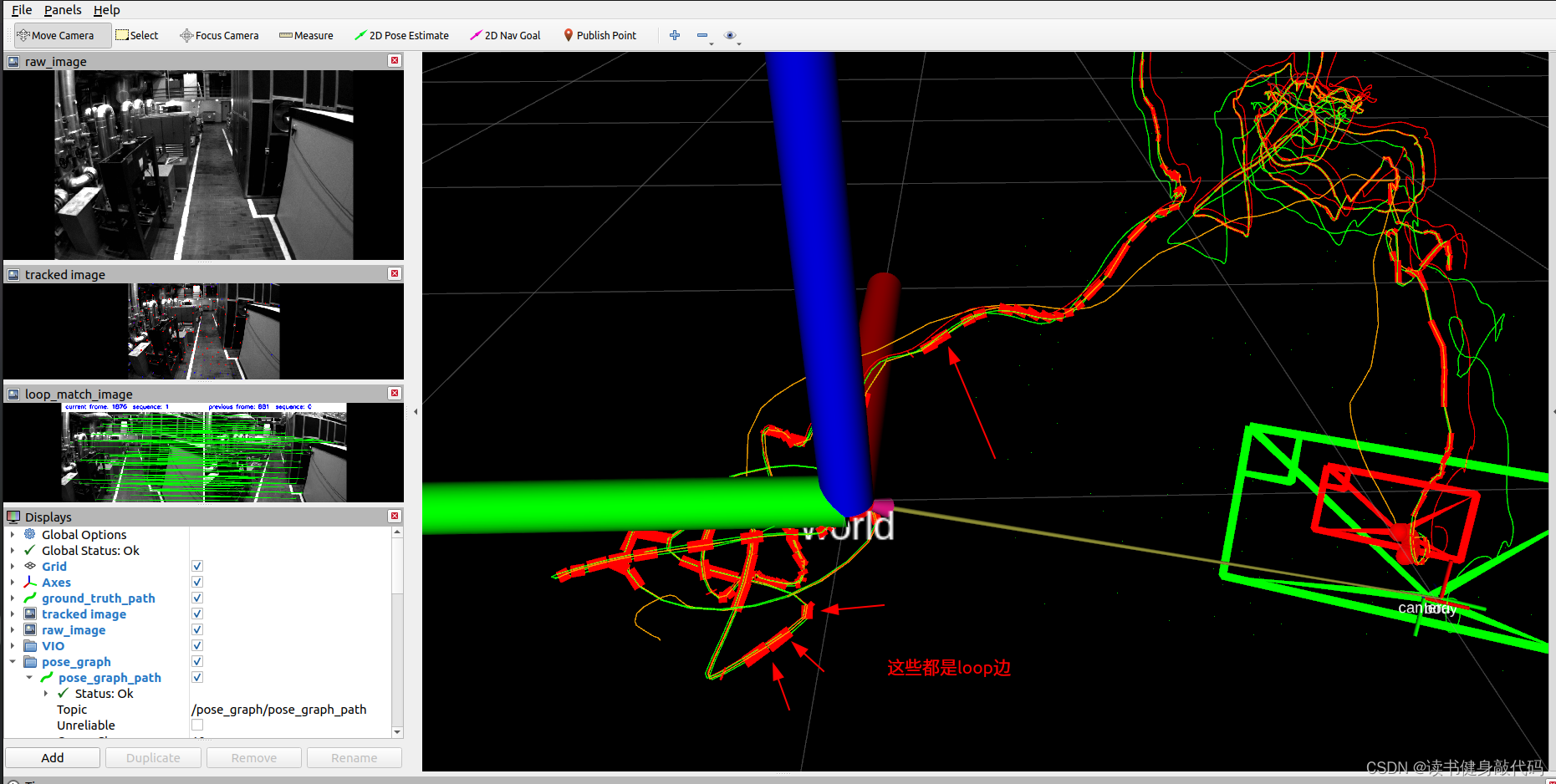
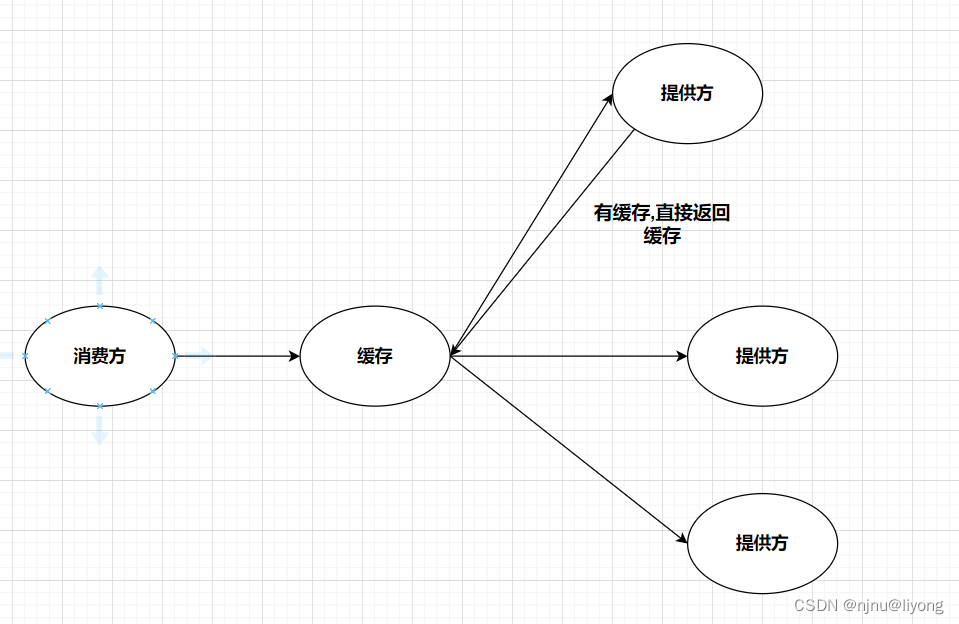
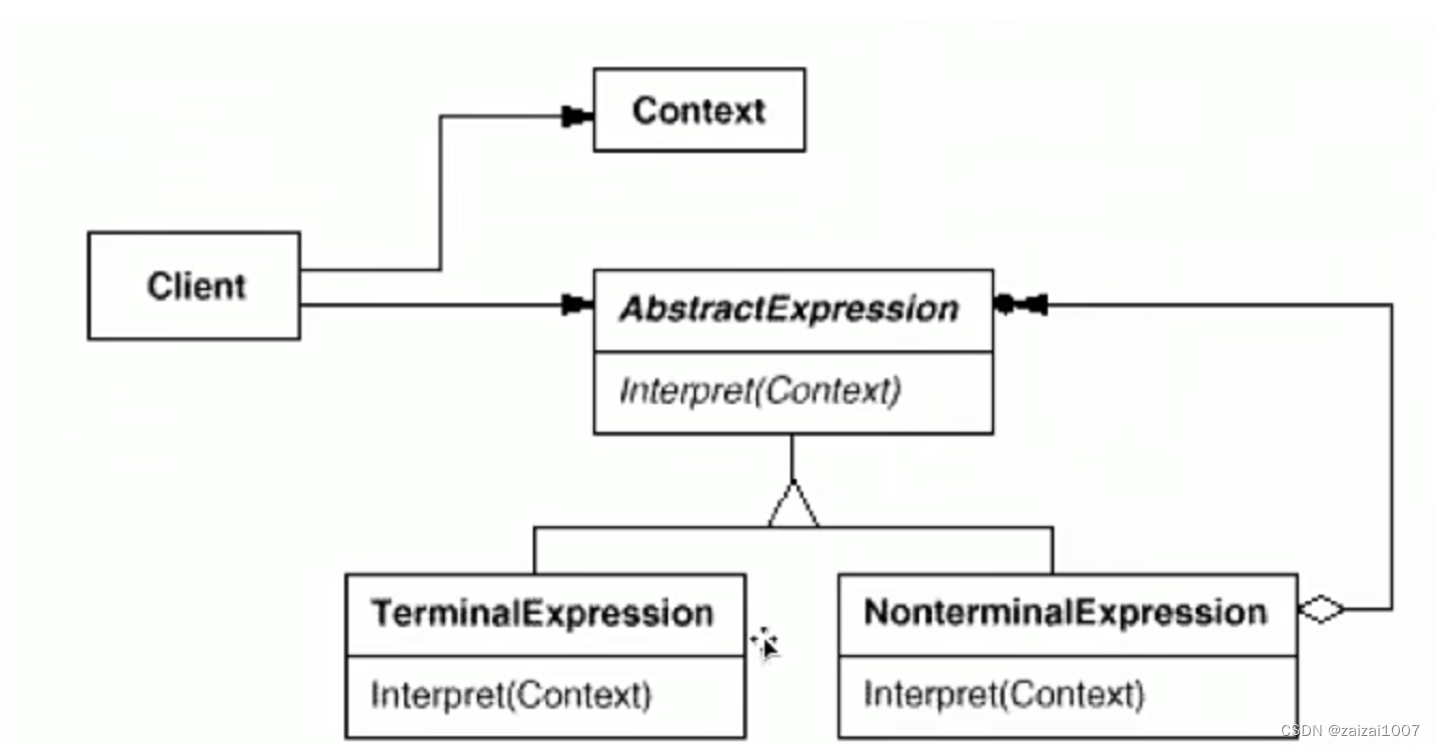



![[HCTF 2018]Warmup](https://img-blog.csdnimg.cn/direct/778e2b7889e047d2ae2e032e30d9a14f.png#pic_center)
